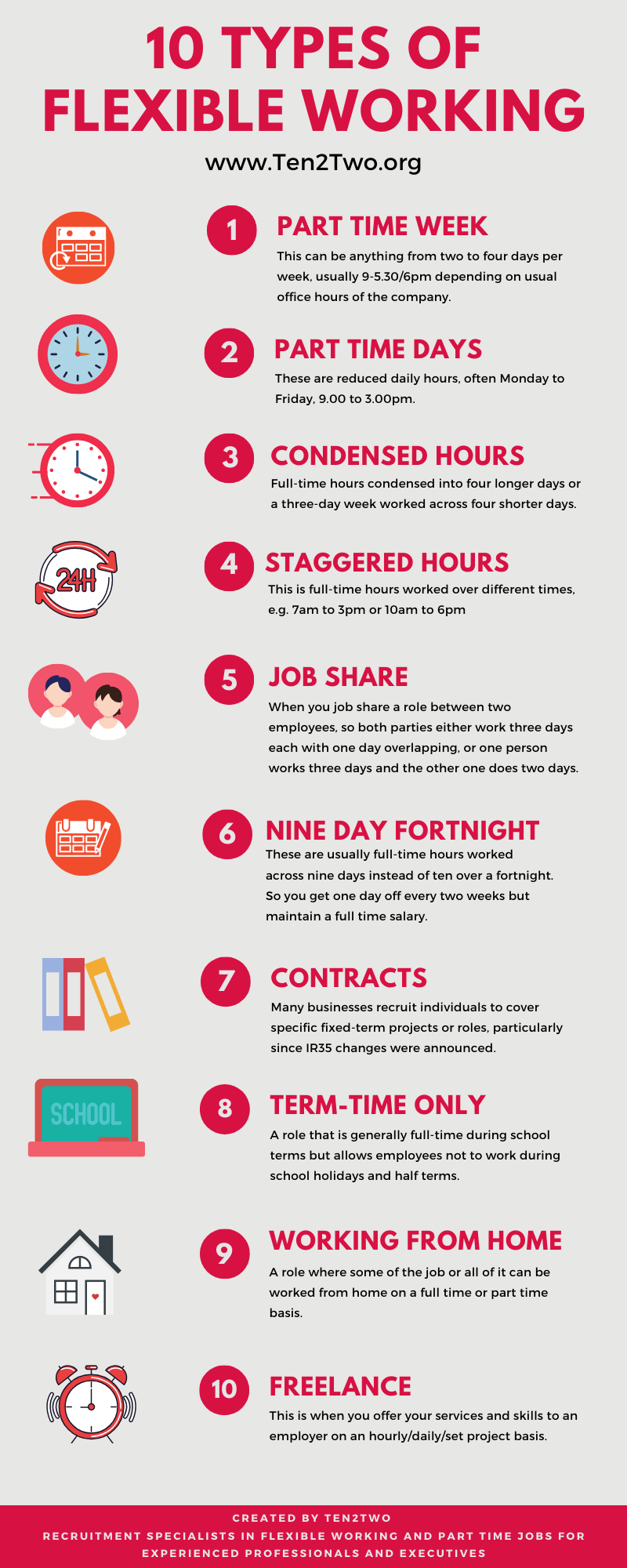The ultimate guide to different types of flexible working
Now that more and more people are working remotely or from home, a lot of people are talking about different types of flexible working. Remote working or working from home is just one aspect of this. Flexible working can also mean the different working patterns outside of the standard nine-to-five office hours.
So if you’re considering different types of flexible working or if you’d like to hire flexible talent, have a read and see how flexible working patterns might benefit you.
10 Types of Flexible Working
1. Part-time week
This can be anything from two to four days per week, usually 9-5.30/6pm depending on the office hours of the company.
Benefit: Some parents find they have fewer inset days or holiday childcare to find by working a flexible pattern like this. For businesses they can hire someone to work reduced hours gaining valuable skills. This format can also be useful for small businesses wanting to ‘seem’ larger in size.
2. Part-time days
These are reduced daily hours, often Monday to Friday, 9.00 to 3.00pm.
Benefit: This can be a useful flexible work pattern when juggling school drop off and pick up commitments. This format is useful for employers who need daily attendance in a client-facing role or where daily contact is required with staff or team members.
3. Condensed hours
Full-time hours condensed into four longer days or a three-day week worked across four shorter days.
Benefit: If you work full-time hours over fewer days, you can still benefit from a full-time salary as well as having a day off once a week. This option delivers cost savings to businesses and flexibility to the employee with little loss of working capacity.
4. Staggered hours
This is full-time hours worked over different times, e.g. 7am to 3pm.
Benefit: This flexible working example is handy if you want to beat busy commuting times, ideal if you drive to work. Like condensed hours, this offers flexibility for the employee with no loss of capacity for the employer – a win-win situation!
5. Job share
When you job share a role between two people, so both parties either work three days each with one day overlapping, or one person works three days and the other one does two days.
Benefit: There are so many job share benefits, including having two heads working as one – useful for employers and employees alike. We find that often when an employee wants to move to part-time hours, employers can cover the work by hiring a second employee to fulfil the role.
6. Nine-day fortnight
These are usually full-time hours worked across nine days instead of ten over a fortnight. So the employee gets one day off every second week.
Benefit: A nine-day fortnight lets the employee work a full-time role with a full-time salary. The day off can also give employees the flexibility they need with a day off every other week. It is useful for employers too as they can give staff flexibility with little loss of capacity.
7. Short-term/medium term contracts
Many businesses recruit individuals to cover specific fixed-term projects or roles, particularly since IR35 changes were announced.
Benefit: This is a flexible working example that can allow an employee to get their teeth into a role either on a full-time or part-time basis, with a view to a set end date. Ideal if you wish to work term-time only and around school holidays. It’s also helpful for businesses who wish to recruit but a new permanent employee is not required long-term.
8. Term-time contracts
Some roles are set around school terms, such as HR or administrative workers in colleges, universities or in council offices.
Benefit: If you have children, a term-time contract can be very useful to save money on childcare in the school holidays and spend more time with your children. However, you won’t be paid for this time usually. It can also be cost-effective for employers who have peak business times that usually fall outside of the summer months.
9. Working remotely
A role where some of the job or all of it can be worked remotely or worked from home. This can be written into your contract and allows you to reduce your commuting costs, so you have more time to devote to tasks at home or to focus on more complicated tasks that require concentration.
Benefit: This can be useful for employees who live a long way from a city or place of work. For employers, they can reduce overheads and work just as efficiently with an employee or team of people who are remote workers especially with the progress in virtual meeting technology.
10. Freelance
This is when you offer your services and skills to an employer on an hourly/daily/set project basis.
Benefit: Freelance contractors are self-employed and this can mean huge savings for businesses who don’t have costly hiring costs to work around. For the employee, they have the flexibility to pick up work that fits around family life. For employers, they have the opportunity to get projects done without making a costly long-term hire.
Talk to our flexible recruitment agency today
We know that these flexible working examples can be useful for all sorts of reasons to help people fulfil their professional and personal lifestyle needs. For most people, that need becomes most pertinent once they start a family.
If you’d like to find a flexible or part-time role today, please register with our recruitment agency, Ten2Two. Equally, if you have a business need for recruitment, a flexible employee can make cost-effective business sense – so please get in touch.


 Back to resources
Back to resources
 5 min read
5 min read








